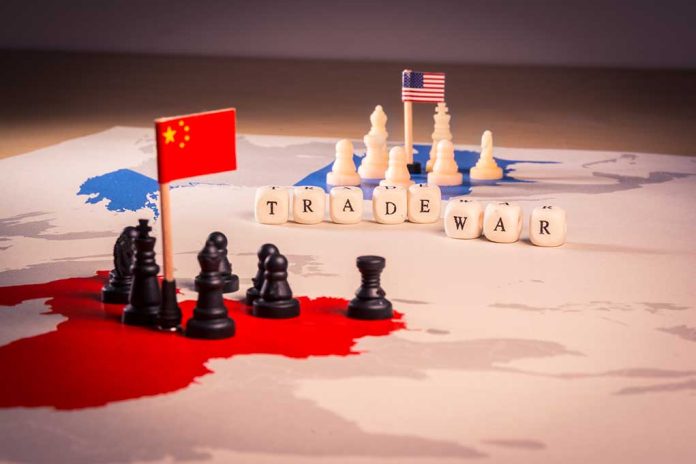
The Trump administration has reached a 90-day agreement with China to slash tariffs by 115%, reducing rates from over 140% to just 30% for American importers, signaling a potential thaw in the trade war that has disrupted global markets.
Key Takeaways
- US tariffs on Chinese goods will drop from 145% to 30%, while Chinese tariffs on American products will decrease from 125% to 10%, creating a substantial 115% reduction in bilateral tariffs.
- The 90-day agreement maintains higher 20% tariffs on fentanyl-related products while establishing a framework for ongoing trade discussions.
- Global financial markets rallied on the news, with significant gains in European and Asian markets and a 1% rise in the US dollar index.
- Wall Street analysts describe the deal as a “dream scenario” and “better than expected,” potentially leading to inventory increases and renewed demand for container freight.
- A formal mechanism for continued economic discussions will be led by Chinese Vice Premier He Lifeng, US Treasury Secretary Scott Bessent, and US Trade Representative Jamieson Greer.
Dramatic Tariff Reductions Exceed Market Expectations
The United States and China have reached a significant trade agreement following negotiations in Geneva, Switzerland, that will reduce reciprocal tariffs by 115 percentage points for a 90-day period. US tariffs on Chinese imports will drop from a prohibitive 145% to a more manageable 30%, while China has agreed to decrease its tariffs on American goods from 125% to just 10%. Both nations have committed to implementing these changes by Wednesday.
The agreement represents a substantial de-escalation in trade tensions between the world’s two largest economies. While maintaining a 20% tariff on fentanyl-related products, the US will reduce other tariffs by 24 percentage points to a 10% ad valorem rate. Additionally, China has agreed to suspend or remove non-tariff countermeasures against the US that had been implemented since April 2, when President Trump announced the latest round of tariffs.
🚨 The US to cut tariffs on Chinese goods to 30% from 145% for 90 days.
Futures are up BIG pic.twitter.com/vWAt9CvVaL
— Crypto | Stocks | Freedom (@Wealthmanagerrr) May 12, 2025
Markets Rally on Trade Deal News
Financial markets worldwide responded positively to the announcement, with substantial gains across European and Asian markets. US stock futures indicated a positive trend for American markets as well. The US dollar index rose by 1%, and the yield on the 10-year Treasury note increased by 6 basis points. Wall Street strategists anticipate that US stocks will outperform European counterparts in the short term.
The effective US tariff rate on Chinese imports has been reduced from 108.8% to 27%, a move that Deutsche Bank strategists described as exceeding “constructive expectations.” The temporary agreement is expected to boost inventory increases and stimulate demand for container freight, potentially reversing the declines in shipping and freight observed since April when trade tensions escalated.
Framework for Long-term Trade Resolution
Beyond the immediate tariff reductions, the agreement establishes a mechanism for ongoing discussions about the US-China economic and trade relationship. These talks will be led by Chinese Vice Premier He Lifeng, US Treasury Secretary Scott Bessent, and US Trade Representative Jamieson Greer. The discussions may take place alternately in China, the United States, or a third country, with additional working-level consultations as needed.
The 90-day timeframe is viewed by analysts as insufficient for developing a detailed long-term agreement but maintains negotiation pressure on both sides. The joint statement emphasized the importance of developing a sustainable, long-term, and mutually beneficial economic relationship. This represents a significant shift from the intense trade war that has characterized US-China relations, with China being the only country to consistently retaliate against US tariffs, leading to escalation on both sides.
Economic Impact and Future Prospects
Trade between the US and China is expected to resume swiftly under the new tariff regime. Analysts describe the deal as a “dream scenario” and a “huge win for the market and bulls,” with expectations for further tariff reductions and new market highs in the months ahead. The 90-day window provides businesses with a critical opportunity to adjust supply chains and rebuild trade relationships that had been disrupted by escalating tariffs.
The agreement follows months of increasing trade tensions that had created uncertainty in global markets. While the temporary nature of the deal leaves questions about long-term trade policy, it provides immediate relief for businesses and consumers affected by higher prices resulting from the previous high tariff rates. Both nations appear committed to finding a path toward sustainable economic cooperation, marking a potential turning point in the US-China trade relationship.
Sources:
A ‘huge win’ for bulls: Markets soar on U.S.-China deal as Wall Street sees more upside
Reactions to US-China tariff cuts
US, China announce reduced tariffs for 90 days after trade talks







